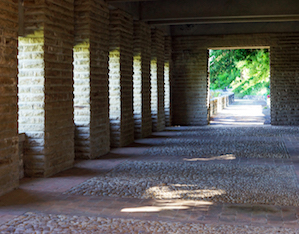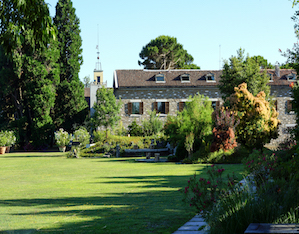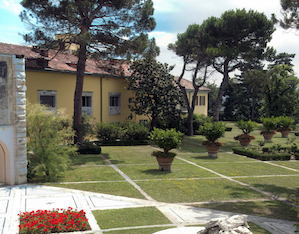The Ottolenghi-Wedekind estate in Monterosso, is one of the most refined works by landscape architect Pietro Porcinai. This property dominates the wine-growing landscape of the Acqui hills and is an emblem of the commitment of the two enlightened patrons who during the 20th century made it “an acropolis of the arts” .
In 1923, on the hill of Monterosso in Acqui, Count Arturo Ottolenghi and German sculptress Herta Wedekind zu Horst initiated the creation of a unique artistic context, a crossroads open to architects, sculptors, painters, interior designers, landscape architects and gardeners of excellence. The project of the two patrons, that was abruptly interrupted by the outbreak of the War and their death in the early 1950s, has been continued by their son Astolfo, who commissioned Giuseppe Vaccaro and Pietro Porcinai to complete the work his parents had started. Between 1955 and 1962, the Florentine landscape architect designed and executed a project for the garden and the entire estate connecting the fragmented architectural components on the property. Porcinai designed an ascending pathway unravelling from the provincial road below, near the ancient cemetery of Acqui Terme, and connecting the property’s various outbuildings introduced by a large fountain and Arturo Martini’s sculptural group depicting Adam and Eve, an evocation of the original Garden of Eden. Among the vineyards is the Mausoleum, a work begun in 1929 designed by Marcello Piacentini. At the top of the estate is the villa with the rationalist architecture of the artists’ ateliers, providing a scenographic backdrop to ponds from which Tobiolo’s statue emerges. On the southern side is the formal garden, in continuity with the patio designed by Giuseppe Vaccaro, whose chessboard of black and white pebbles is translated into a reticular design of stone and lawn, alternating with beds of roses and boxwood. Maritime pines and a row of citrus vases guides the perspective towards the vast hilly landscape.
Highlights

Cisternone
This geometrically imposing cistern was designed by Giuseppe Vaccaro to collect the water to be used to irrigate meadows and vineyards. Its monumental interior, lined in fossil stone and featuring large, bright openings, is guarded by a bronze triton sculpture by Herta, set above the water surface.

The rock garden
Set at a crossroads between the villa's private areas and its public spaces, a small elevation gave Porcinai the opportunity to create a rock garden with circular terraces lined with oaks, maples, tamarisks and his beloved "smoke trees" (Cotinus coggygria).

Acqui Terme and Monferrato
Villa Ottolenghi is located in an area of great importance, home to the nearby ville d'eauAcqui Terme with its major and traditional spas, and the hilly landscape of Monferrato, shaped by the passing of the river Bormida and the cultivation of vineyards, from which the famous Brachetto d'Acqui wine is produced.
 Villa Ottolenghi Wedekind
Contacts
Villa Ottolenghi Wedekind
Contacts
Contacts
Telephone:+39 0144 322177
+39 335 6312093a
Address
Strada Monterosso, 42
15011, Acqui Terme (AL)
 Villa Ottolenghi Wedekind
Opening times and prices
Villa Ottolenghi Wedekind
Opening times and prices
Opening hours
Guided tours take place on Saturday and Sunday afternoons:
- from 15 June to 15 September at 4.30 p.m.
- from 16 September to 14 June at 2.30 p.m.
- Departure: Second gate
For reservations contact: [email protected]; +39 335 6312093
Pricing
ENTIRE GUIDED TOUR € 15,00 Visit of the Villa, the Park, the Formal Garden, the Temple of Herta, Artists’ Studios, Cisternone and Cantina. Duration of the visit minimum 2 hours. At the end of the visit there will be a tasting of wines produced with the grapes of the Vigne Giardino (P. Porcinai) VILLA AND GARDEN € 10,00 (under 12 years old: free of charge) Visit of the Villa and Garden. Tasting of wines from the estate of the Dominio di Borgomonterosso. Approximate duration: 1 hour and a half. HERTA’S TEMPLE € 10,00 (minors 12 years old: free) Visit of Herta’s Temple. Advance booking required – Minimum 5 people. Approximate duration: 1 hour VILLA AND TEMPLE € 15,00 Visit of the Villa, Garden and Temple of Herta. Prior booking – Minimum 5 people. Approximate duration: 2 hours and a half (Reservation required)
CONVENTIONS T.C.I., Acri, Fai, Associazione Musei e Mostre 10% discount
(For school groups: accompanying persons and teachers have free admission).
 Villa Ottolenghi Wedekind
How to get there
Villa Ottolenghi Wedekind
How to get there
Address
Strada Monterosso, 42
15011, Acqui Terme (AL)
Latitude: 44.6953996
Longitude: 8.4795739
How to arrive by road
Motorway A7 exit Ovada, continue on A231 exit Alessandria Sud. Take SP30 direction Acqui terme until arrival.
How to arrive by train
The Villa can be easily reached from the Acqui Terme train station from which you can continue by taxi to the complex.
How to arrive by bus
Line 022 Alessandria – Cassine – Acqui Terme operated by Arfea Srl.
 Villa Ottolenghi Wedekind
Services/Accessibility
Villa Ottolenghi Wedekind
Services/Accessibility
Services
It is possible to stay overnight in the suites provided by the villa.
It is possible to stay overnight in the suites provided by the villa.
It is possible to stay overnight in the suites provided by the villa.
It is possible to stay overnight in the suites provided by the villa.
You can book guided tours for individuals and groups by calling +39 335 6312093 or writing to [email protected]
Restaurant
The restaurant is open Thursday, Friday and Saturday from 7:30 pm to 9.00 pm and Sunday from 12:30 am to 1:30 pm. For information and reservations +39 335 6312093 or [email protected]
 Villa Ottolenghi Wedekind
Private events
Villa Ottolenghi Wedekind
Private events
Possibility to organize private events in the villa.
 Villa Ottolenghi Wedekind
Itineraries
Villa Ottolenghi Wedekind
Itineraries
You could find the garden in these itineraries
 Favorite saving result
Favorite saving result
 Warning!
Warning!
You've have to sign up or sign in to add this element to your favorites.
